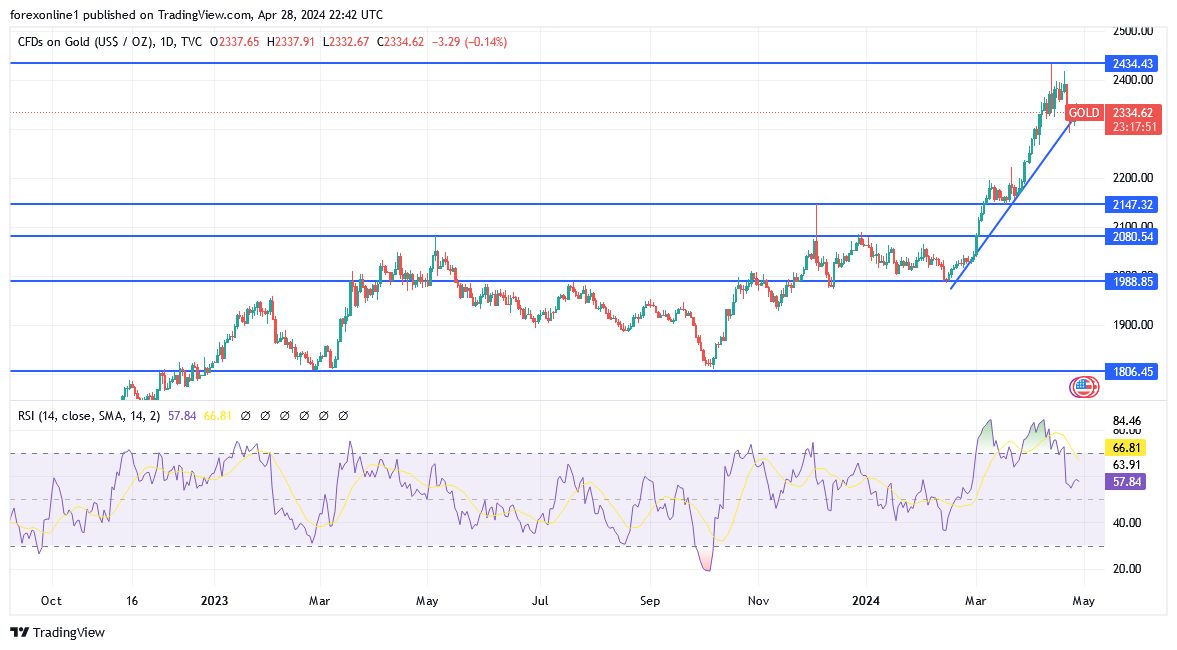- At the end of last week's trading sessions, gold futures managed to capture some gains as financial markets shrugged off the latest inflation data.
- Despite widespread expectations that the US Federal Reserve would keep interest rates high for longer, stocks formed a reflection of the selling pressure witnessed on Thursday.
- Now, the question arises: Is gold looking to revisit $2400 per ounce again?

According to gold trading platforms, prices rose on Friday to the resistance level of $2352 per ounce before settling around $2333 at the beginning of an important and eventful week of trading. The price of the yellow metal was poised for a weekly decline of 2.2%, but it remains up by nearly 14% since the beginning of 2024.
Similarly, silver prices, the sibling commodity to gold, rose above $27 per ounce. Overall, silver also trended towards a weekly decline of 4.3%. However, like gold, silver prices have risen by approximately 15% so far this year.
Top Forex Brokers
Overall, all eyes were on the preferred US inflation gauge by the Federal Reserve: The Personal Consumption Expenditures (PCE) Price Index. According to economic calendar data, in March, the Personal Consumption Expenditures (PCE) Price Index rose higher than expected, reaching 2.7%, compared to 2.5% in February, according to the Bureau of Economic Analysis (BEA). The market had expected a reading of 2.6%. On a monthly basis, the inflation rate in personal consumption expenditures rose by 0.3%, unchanged from the previous month and in line with market expectations.
The core Personal Consumption Expenditures (PCE) Price Index, which excludes volatile food and energy sectors, remained at 2.8%, but came in higher than the agreed estimate of 2.6%. Recently, the core PCE Price Index jumped by 0.3% from February to March. On a three-month basis, the core PCE Price Index rose to 4.4%. Also, the inflation rate in core personal consumption expenditures excluding housing increased to 3.5% on an annual basis and rose by 0.4% monthly.
In other economic data, personal spending increased by 0.8% for the second consecutive month, surpassing market expectations of 0.6%. Personal income jumped by 0.5%, up from 0.3%, in line with expectations. Furthermore, personal saving rate fell from 3.6% to 3.2%. Despite the latest indicators pointing to a second wave of inflation and a longer period of higher interest rates, investors remained unconcerned as key indices rose by as much as 1.85%.
Meanwhile, this supported the gold market as the US Treasury bond market weakened, despite the strength of the US dollar curbing gains. US Treasury yields were in the red across the board, with the 10-year bond yield falling by 5.3 basis points to 4.65%. Moreover, the yield on 2-year bonds fell below 4.99%, while the yield on 30-year bonds fell below 4.77%.
Another factor affecting gold, the US Dollar Index (DXY), which measures the US currency against a basket of other major currencies, rose to 105.95, from the opening at 105.60. Obviously, the stronger dollar typically brings gold prices down as it makes buying it more expensive for foreign investors. Meanwhile, according to the CME Federal Reserve Watch Tool, the futures market is now heading for only a one-quarter-point cut in US interest rates this year.
Moreover, this supported the gold market as the government bond market weakened, although a stronger US dollar limited gains. US Treasury yields were in the red across the board, with the 10-year bond yield falling 5.3 basis points to 4.65%. Also, the two-year bond yield fell below 4.99%, while the 30-year bond yield fell below 4.77%.
Another factor affecting gold, the US Dollar Index (DXY), which is a measure of the US currency against a basket of other major currencies, rose to 105.95, from opening at 105.60. A stronger dollar is usually bearish for gold prices because it makes it more expensive for foreign investors to buy. Meanwhile, according to the Fed's CME monitoring tool, the futures market is now set to cut US interest rates by just a quarter of a point this year.
Gold Price Forecast and Analysis Today:
According to the performance on the daily chart attached, the price of gold is still in an attempt to avoid further losses, and the success of the bulls in returning to the vicinity of the resistance levels of 2385 and 2420 dollars per ounce is possible in the event that the price of the US dollar declines in the wake of the US Federal Reserve Bank’s announcement and the US job numbers. In addition to increasing global geopolitical tensions and increasing central banks’ purchases of gold. On the other hand, breaking the level of $2,300 per ounce is possible if the dollar continues to strengthen and investors’ appetite for risk increases.
